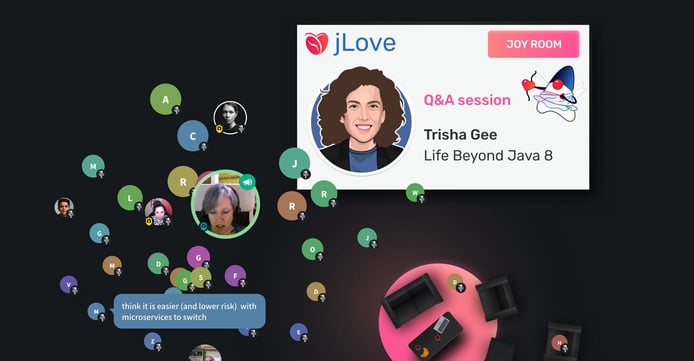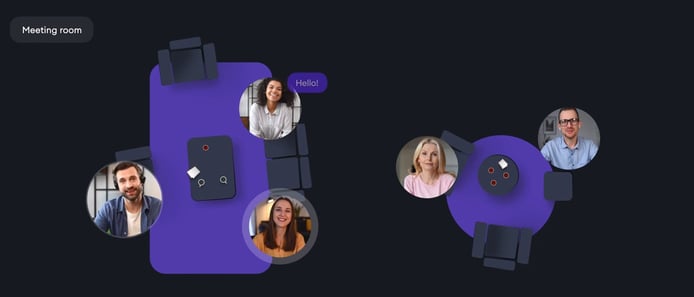
TL; DR: SpatialChat is a platform for in-person virtual meetings that its founders developed long before the COVID-19 pandemic moved daily social interactions online. The company’s software aims to recreate the in-person experience for a wide range of use cases, including networking events, classroom learning, and even daily work in an office setting. As work paradigms continue to evolve, SpatialChat has positioned itself as a cloud-hosted solution for modern workers and friends who want to communicate or interact with each other.
When the SpatialChat team recently met for a company retreat, an observer would probably have no idea it was the first time many employees had seen each other in person.
That’s because the company had been using its own product: A dynamic collaboration software that recreates the experience of in-person meetings, presentations, and networking events.
“In-person meetings matter because they involve common social experiences,” said SpatialChat CEO Almas Abulkhairov.

Almas said SpatialChat seeks to go a step further than other ubiquitous products, including Zoom, Microsoft Teams, and Google Meet, that have taken off following the COVID-19 pandemic.
Almas said SpatialChat’s software-as-a-service product was born out of his and three friends’ desire to stay in close contact with each other — even though they lived in different countries.
The four companions were busy with separate endeavors but started to lay the groundwork for a new kind of communication platform. After 29 failed attempts over four years, they built one that worked in December of 2018.
Then came March 2020, which provided the impetus they needed to make SpatialChat a reality.
Recreating the In-Person Experience
The onset of the COVID-19 pandemic changed everything for businesses around the world. It also led to the resurgence of SpatialChat.
“The world wasn’t ready, and we said, ‘Hey, remember that thing we created?’” Almas said.
SpatialChat officially launched on April 20, 2020. Almas said the team began to focus more on SpatialChat after the pandemic, even though they had no investors yet.
Today, SpatialChat has 42 employees who work remotely from eight countries. The company also has about 6,000 customers worldwide and has reached profitability, according to Almas.
SpatialChat aims to recreate physical interactions as closely as possible. For example, Almas demonstrates that moving away from the screen while talking on SpatialChat results in the person’s voice sounding farther away, so the avatar on the screen also moves away.
“It allows people to have a sense of each other, and of body language,” Almas said.
In a networking setting, users can approach someone and get their attention to make an introduction in much the same way they would in person.
It also allows people to break out into different corners of the same room without being overheard by others. But if someone walks toward that corner, they will slowly begin to hear the conversation.
Those features can allow teachers to virtually walk around a classroom as students work together. SpatialChat aims to recreate those personal, visceral experiences.
“With remote work, we miss that social interaction when we see each other in Slack or Zoom where we are just rectangles to each other,” said Almas.
Work, Learn, or Network Without Screen Fatigue
The use cases for SpatialChat’s cloud-hosted platform include networking events, daily work in an office, or learning in a classroom. Other platforms allow users to video conference, but Almas points out that when users just stare at a screen, it can quickly lead to fatigue.
“SpatialChat duplicates the physical experience of space,” Almas said.
For instance, if you were meeting in a conference room within an office on SpatialChat, you could see other people working there — even if they are in different rooms.

“There’s a psychological connection that people are physically there,” Almas said. That helps combat the feeling that there’s nothing else happening besides your specific meeting.
He said SpatialChat offers “micro-experiences” that users can’t get on the other platforms.
“These micro-experiences, like being able to approach people and get their attention, add up to the full experience,” Almas said.
Another way that SpatialChat distinguishes the user experience is through customizable spaces. For example, different rooms can have a color, theme, or company logo that conveys its purpose.
“It’s a virtual venue for your event, it’s a virtual campus for students or a virtual office for your company,” said Almas.
He said the ultimate goals for hosting connections on SpatialChat are often to streamline workflows and foster better collaboration.
Businesses Will Continue With Remote Work
When a company has an office hosted on SpatialChat, it can create multiple rooms — or floors — where various teams work, just like employees would find in a physical office. That could very well become a standard feature of many businesses as the paradigm of work continues to evolve in a post-pandemic world.
Many businesses are evaluating their approach to working physically, remotely, or in a hybrid fashion. That presents a significant opportunity for SpatialChat, but remote work was becoming more common even before people needed to stay home to avoid the spread of COVID-19.

“We believe in the trend that was already happening,” Almas said. “The pandemic was a catalyst, but not a reason that people were going remote. It only made the transition faster.”
Almas pointed out that Google received thousands of requests from employees who were seeking to work from home. And numerous businesses are already paying attention to what SpatialChat is doing. Almas said the company has some Fortune 500 customers who use it for their internal meetings.
SpatialChat: Anticipating Communication Needs of the Future
Almas and his team understand that communication preferences are ever-changing. To that end, SpatialChat is poised to play a role in the next frontier of digital communication.
The trend of increasing online communications offers a considerable growth opportunity over the next decade, Almas said. SpatialChat’s success so far shows a small glimpse of how the market has responded to its cloud-hosted communication software — and what the future holds.
More than 1.4 million people participated in over 10,000 events on SpatialChat in its first year. The average daily session per user was 52 minutes and around four hours as a virtual office for a team.
Apart from the business use cases, the company has also seen its platform used for town hall meetings and kick-off events. Some users have even hosted parties on SpatialChat.
SpatialChat gathers plenty of feedback from users and receives suggestions on new features or ways it can improve. That has already led the company to launch several features, including multiple admin management, single sign-on capabilities, advanced analytics for business customers, and increased integrations with Eventbrite, Marketo, and Salesforce.
“We’re going after building the very best remote team communication and collaboration software,” Almas said.
HostingAdvice.com is a free online resource that offers valuable content and comparison services to users. To keep this resource 100% free, we receive compensation from many of the offers listed on the site. Along with key review factors, this compensation may impact how and where products appear across the site (including, for example, the order in which they appear). HostingAdvice.com does not include the entire universe of available offers. Editorial opinions expressed on the site are strictly our own and are not provided, endorsed, or approved by advertisers.
Our site is committed to publishing independent, accurate content guided by strict editorial guidelines. Before articles and reviews are published on our site, they undergo a thorough review process performed by a team of independent editors and subject-matter experts to ensure the content’s accuracy, timeliness, and impartiality. Our editorial team is separate and independent of our site’s advertisers, and the opinions they express on our site are their own. To read more about our team members and their editorial backgrounds, please visit our site’s About page.



